| Medieval Troubadours |
|---|
| www.studenthandouts.com ↣ World History ↣ European Middle Ages ↣ Medieval Maps and Pictures |
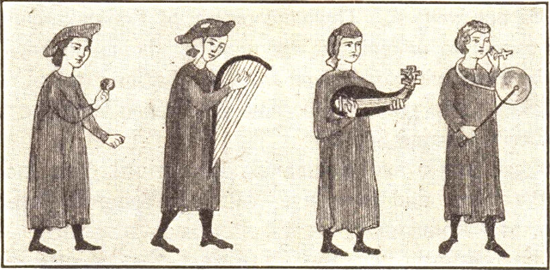 Troubadours: From a twelfth-century manuscript. These strolling musicians sang their songs to the accompaniment of the harp, lute, or other instruments. The second man from the right is carrying a lute, the man behind him a harp.
Troubadours: From a twelfth-century manuscript. These strolling musicians sang their songs to the accompaniment of the harp, lute, or other instruments. The second man from the right is carrying a lute, the man behind him a harp.Click here to enlarge this image. The troubadours were talented poets and musicians who flourished during the High Middle Ages in medieval Europe, primarily in the Occitan-speaking1 regions of what is now southern France. They played a significant role in the development of vernacular literature and the troubadour tradition is often associated with courtly love poetry. Here are some key aspects of the troubadours. Geographic Origin: The troubadours primarily emerged in the region known as Occitania, which encompassed parts of modern-day France, Spain, and Italy. The center of troubadour activity was in the towns and courts of southern France, particularly in regions such as Provence, Aquitaine, and Toulouse. Language: Troubadours composed their poetry in the Occitan language, which was a Romance (meaning "Roman," derived from Latin) language spoken in the south of France. This marked a significant departure from the Latin used in scholarly and religious texts during the medieval period. Themes: Troubadour poetry often focused on themes of courtly love, chivalry, and the ideals of knighthood. The troubadours celebrated the emotions and experiences of courtly love, often in a highly refined and stylized manner. Their poems often depicted the complex and idealized relationships between knights and noblewomen, sometimes involving unrequited love or impossible romantic pursuits. Influence: The troubadour tradition had a profound and largely lasting impact on the development of medieval European literature and poetry. Their emphasis on writing in the vernacular (local) language, rather than Latin, contributed to the growth of regional languages and the spread of vernacular literature across Europe. Troubadour poetry also influenced troubadours in other regions, such as the trouvères in northern France and the minnesingers in Germany. Social Role: Troubadours were often associated with the courts of nobility, where they entertained and served as poets for the ruling class. Their poems were performed and sung, often with musical accompaniment, at courtly gatherings and other social events. Decline: The troubadour tradition began to decline in the late Middle Ages, partly due to social and political changes in Europe. The Albigensian Crusade2 and the Inquisition in the 13th century, which targeted heretical movements in Occitania, also had a detrimental impact on the troubadour culture. Legacy: Despite their decline, the troubadours left a lasting legacy on European literature and culture. Their poetry paved the way for the development of secular (non-religious) literature and the romance genre, and their influence can be seen in later works such as the Arthurian legends and the poetry of Dante Alighieri. Summa summarum3, the troubadours were medieval poets and musicians who composed courtly love poetry in the Occitan language, primarily in southern France. They played a crucial role in the development of vernacular literature and left a lasting impact on the European literary tradition. |
|
1 A Romance language of southern France, also spoken in parts of Italy and Spain's Val d'Aran. 2 The 13th-century crusade called by the pope against the Cathar heresy in southern France, which devastated Occitan culture. 3 In summary. |
 | 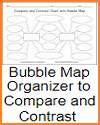 | 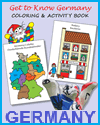 | 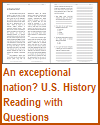 | 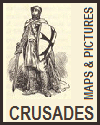 | 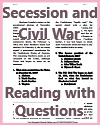 |
| Middle Ages Books and Films | Middle Ages Outlines and PowerPoints |
| Middle Ages Maps and Pictures | Middle Ages Study Games |
| Middle Ages Miscellany | Middle Ages Printable Worksheets |
| www.studenthandouts.com ↣ World History ↣ European Middle Ages ↣ Medieval Maps and Pictures |








